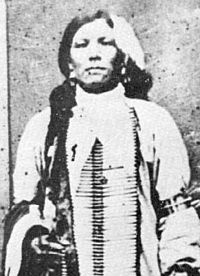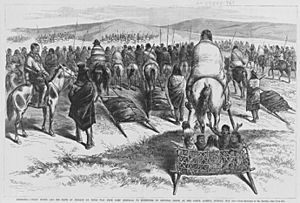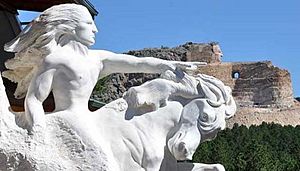Crazy Horse facts for kids
Quick facts for kids
Crazy Horse
|
|
|---|---|

Could be photograph of either Crazy Horse or his brother.
|
|
| Born | c. 1838 |
| Died | September 5, 1877 |
Crazy Horse was a brave Native American war leader. He belonged to the Oglala Lakota people in the 1800s. He fought to protect his people's land and their traditional way of life. This was during a time when American settlers were moving onto Native American territories.
Crazy Horse was known for his role in important battles. One famous fight was the Fetterman Fight in 1866. He also helped lead his people to victory in the Battle of the Little Bighorn in 1876. These actions earned him great respect from everyone, including his enemies.
In September 1877, Crazy Horse surrendered to U.S. troops. He was later fatally wounded while being held at Fort Robinson in Nebraska. Today, Crazy Horse is remembered as one of the most famous Native American warriors. The United States Postal Service even honored him with a postage stamp in 1982.
Early Life of Crazy Horse

Historians are not completely sure about the exact year Crazy Horse was born. Most believe he was born between 1840 and 1845. His parents came from two different tribes of the Lakota people.
His father, born in 1810, was also named Crazy Horse. When he was born, Crazy Horse was named Cha-O-Ha. This name meant "In the Wilderness" or "Among the Trees." It showed his strong connection to nature. His mother, Rattling Blanket Woman, gave him the nickname "Curly" or "Light Hair." This was because his light, curly hair looked like hers. She passed away when Crazy Horse was only four years old.
Crazy Horse was known for being a quiet and modest person. He was also very generous. He often helped those in need, such as the poor, the elderly, and children.
As he grew older, Crazy Horse became a respected warrior. His fame among the Lakota people grew throughout the late 1850s and early 1860s. Many stories about his bravery were shared in their oral histories.
Crazy Horse's Family
Crazy Horse was married twice. His first wife was named Black Shawl. His second wife was Nellie Larrabee. Only Black Shawl had a child with him, a daughter named They Are Afraid of Her. Sadly, their daughter passed away when she was only three years old.
Crazy Horse Memorial
Today, a huge monument is being carved to honor Crazy Horse. It is called the Crazy Horse Memorial and is located in South Dakota. This monument is being carved into a mountain, similar to Mount Rushmore.
The project was started in 1948 by a sculptor named Korczak Ziółkowski. He had previously worked on Mount Rushmore. When finished, the monument will be very large. It is planned to be 641 feet (195 meters) wide and 563 feet (172 meters) high.
The head of Crazy Horse alone will be the world's largest sculpture of a human head. It will be about 87 feet (27 meters) tall. This is much taller than the 60-foot faces of the presidents on Mount Rushmore. The entire Crazy Horse Memorial will be the largest sculpture in the world.
The memorial is built entirely with money from private donations. It does not receive any help from the U.S. government. There is no set date for when it will be finished. However, the face of Crazy Horse was completed and dedicated in 1998.
The Crazy Horse Memorial Foundation also hosts many cultural and educational events. One popular event is the Volksmarch. During this event, the public can walk onto the monument grounds. The foundation gets most of its money from visitors. Over one million people visit the memorial each year.
There is some discussion about whether the picture often called "Crazy Horse" is truly him. Crazy Horse did not want to be photographed during his life. He strongly believed in keeping the traditional ways of Native Americans.
See also
In Spanish: Caballo Loco para niños


